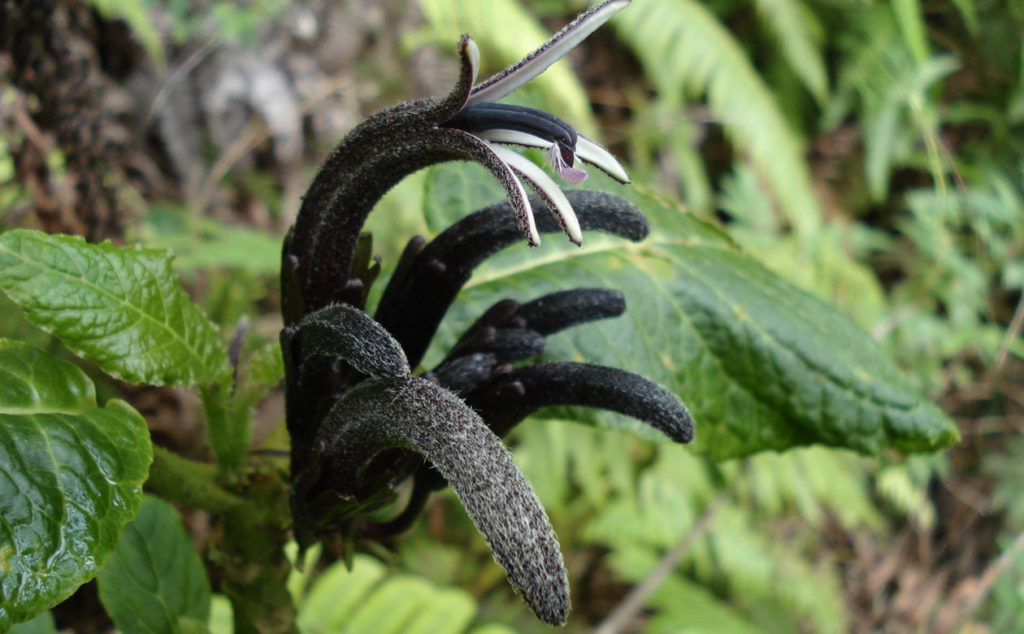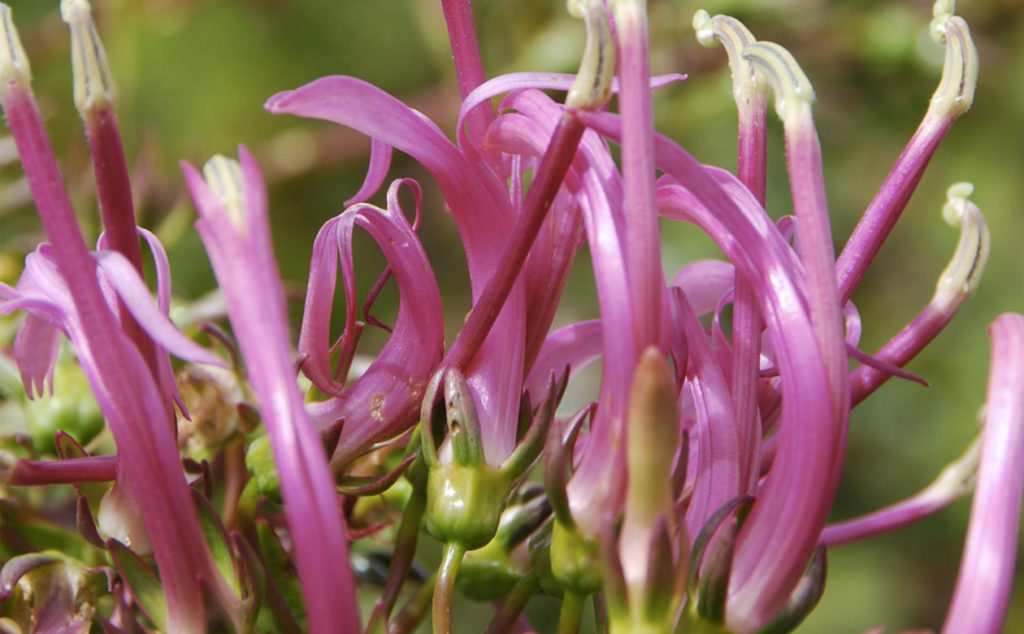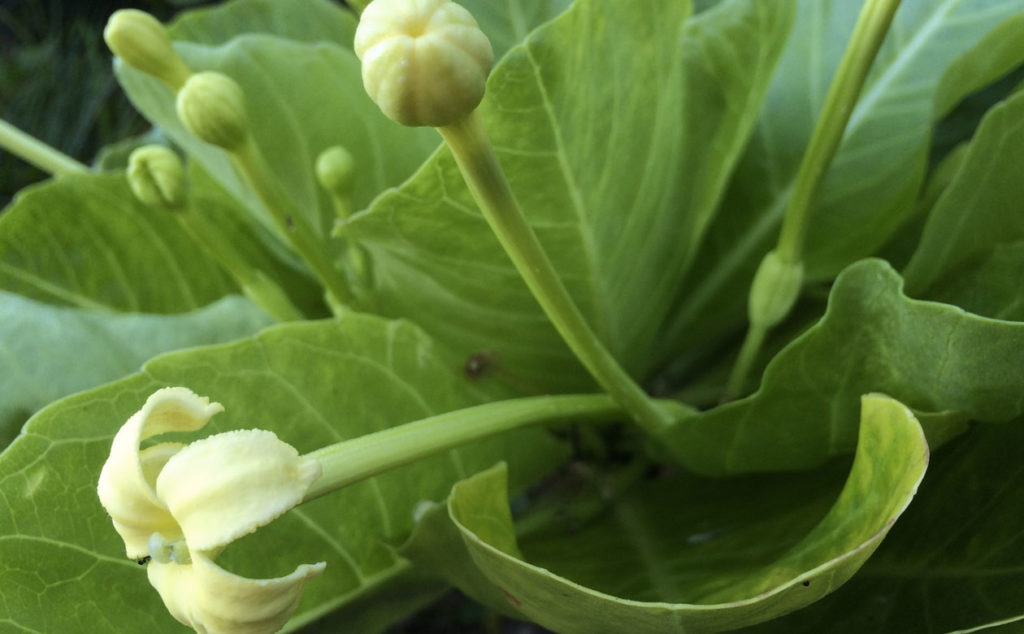
PHOTO caption/credit: Critically Endangered Cyanea gibsonii, endemic to Lāna‘i. Photo by Steve Perlman
Growing on every continent except Antarctica, Campanulaceae (the bellflower family), with around 85 genera and over 2,300 species, has covered the earth. From Australia’s delicate lavender Campanula and clusters of Asyneuma in the sub-alpine meadows of the Caucasus, to sturdy Lobelia deckenii on the slopes of Kilamanjaro and tiny Cyphocarpus, endemic to Chile’s Atacama desert, Campanulaceae is a vision of diversity.
In Hawai‘i, where a lone colonizing species of Lobelia landed some 13 million years ago, the wide range of micro-habitats, as well as adaptations to seed dispersal and pollination by native animals, allowed it to branch and evolve into Hawai‘i’s most diverse clade (related plant group). An exceptional example of adaptive radiation, Hawai‘i’s Campanulaceae include native Lobelia plus five genera endemic to Hawai‘i: Brighamia, Clermontia, Cyanea, Delissea, and Trematolobelia. The more than 150 endemic taxa are found on all the high Hawaiian islands except Kaho‘olawe.
Among some taxa, the characteristic curved floral tubes indicate possible coevolution with curved-beaked native forest birds — mostly honeycreepers (Drepanididae) — while the long, tubular, fragrant flowers of Brighamia suggest adaptation to moth pollination.

Along with the loss of Hawai‘i’s native forest birds, genetic exchange and seed dispersal have declined. NTBG Research Biologist Ken Wood recalls frequently seeing Cyanea and Delissea in the 1980s, but says that populations lost in tropical storms often couldn’t reestablish themselves. Today, Hawai‘i’s Campanulaceae, Ken says, are in sharp decline. In addition to storm damage, competition with alien plants, damage from slugs, rats, and ungulates have reduced populations, adding to the problem of genetic inbreeding, resulting in less robust plants.
Over decades, NTBG scientists have discovered, rediscovered, collected, and cultivated Campanulaceae, most famously the moth-pollinated cliff-dwelling genus Brighamia, represented by just two species: Brighamia insignis, endemic to Kaua‘i and Ni‘ihau, and the closely related B. rockii, endemic to Lāna‘i, Maui, and Moloka‘i.
NTBG Conservation Biologist Seana Walsh has extensively studied the breeding system and floral biology of B. insignis, and continues to collaborate with staff at Chicago Botanic Garden to conduct molecular studies of genetic diversity within and among ex situ collections.
Another genus, Cyanea, includes some 70 or more fleshy fruit-bearing species such as Cyanea dolichopoda, endemic to the sheer cliffs of windward Kaua‘i, it was discovered and co-described by NTBG staff but is now believed to be extinct.
Cyanea kuhihewa, previously known only from Limahuli Valley, was thought to have been wiped out by Hurricane ‘Iniki (1992). It wasn’t until 2017 that an NTBG-Nature Conservancy team rediscovered it on private land. Seeds were collected and sent to Lyon Arboretum at the University of Hawai‘i where they were grown into plantlets and carried back to Kaua‘i in test tubes for NTBG to grow and outplant in the Limahuli Preserve.
NTBG has also successfully cultivated Cyanea superba (extinct in the wild) and C. rivularis which has been outplanted in Limahuli Preserve. Currently, Living Collections staff are also growing C. sylvestris, C. hirtella, as well as a number of Delissea.
In 2012, NTBG’s Senior Research Botanist, Dr. David Lorence, co-named and described Cyanea kauaulaensis which grows in the mountains of west Maui. Presently, NTBG is also conducting survey work on Kaua‘i with an undescribed perennial single-stemmed Lobelia which may eventually be identified as a new species.
To see Hawai‘i’s Campanulaceae in the wild, hike Kaua‘i’s Pihea trail leading to the Alaka‘i Swamp where you may find multiple Cyanea species as well as Clermontia fauriei or Trematolobelia kauaiensis growing along the trail.
Presently, NTBG has more than 612,000 seeds from 370 accessions representing all six native genera in storage. Some of those seeds will be used to establish a breeding program for Brighamia rockii which represent populations no longer extant on Moloka‘i. NTBG will try to germinate those accessions to grow B. rockii and cross-pollinate plants by hand to produce genetically diverse seeds that can be shared with the Plant Extinction Prevention program for outplanting in a restoration site on Moloka‘i, the plant’s home island.
